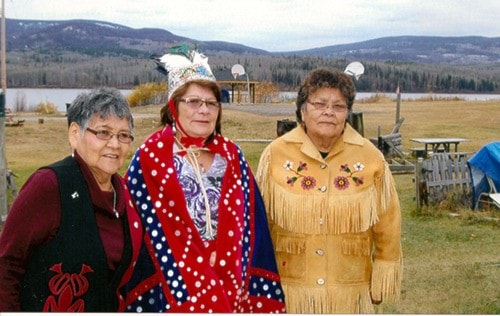Helen Michell of the Skin Tyee First Nation is one of three hereditary chiefs. The Skin Tyee are an independent First Nation that share in the language and culture of the Wet’suwet’en. The Wet’suwet’en have never signed a formal treaty with the government of Canada and are currently active and engaged in consultations with heavy industry regarding mineral exploration on their traditional territories.
“I am Ludooks, caretaker of the land,” Michell explains. “My grandmother and her sisters were part of the Francis Lake tribe in 1916 and we’ve always had hereditary chiefs in our Gilseyhu [Frog] clan from generation to generation. I was chosen when I was born to be a Ludook, so I’ve been groomed for as long as I can remember.”
Michell became concerned when her family and clan’s historical ties to its traditional territories were overlooked recently in last week's coverage of the Huckleberry mine expansion in the Lakes District News. “It’s very disappointing when you read in the paper that the wrong traditional territory is named,” she explained.
The Imperial Metals Ltd. project is located on the west side of the Nechako reservoir in between Sweeny lake and Tahtsa Reach.
“At Sweeny Lake there’s a huge boulder that’s carved into the shape of a frog,” said Michell. “It was done to identify the territory as part of the Gilseyhu clan.”
The Gilseyhu clan is affiliated with the Skin Tyee First Nation through marriage. Michell’s great grandmother married the man who was to become Skin Tyee. ‘Tyee’ means chief in Wet’suwet’en.
“My great grandfather was named Skin and he traded with the first Hudson Bay store in Old Fort on the shores of Lake Babine,” Michell said. “The Hudson Bay company named him Skin because he brought in the most furs. He was a great trapper.”
Little Andrew Bay on the shores of the present-day Nechako Reservoir is named after the Andrews clan. “They had a big trap line on their traditional territory from Andrew Bay to Whitesail,” said Michell. “My great uncles also had traplines there.”
It is a perplexing irony that the Skins Spillway at the east end of the Nechako Reservoir is named after the people it displaced. In 1952 the Kenney Dam was built to flood and create the Nechako Reservoir to power the aluminum plant in Kitimat.
“We were flooded first,” said Michell. “In Andrew Bay and Ootsa Lake we lost our graveyards. That’s why they call it the Skin dam. ”
“The Skin Tyee trapped, fished, hunted and gathered traditional medicines where the Huckleberry Mine is now,” Michell explained. “Trapping was our livelihood and our way of life. We’re still the registered owners of those traplines.”
Michell and the Skin Tyee First Nation are actively involved with the companies doing work on their traditional territories, including the Imperial Minerals and New Gold.
Rene Skin, Chief of the Skin Tyee First Nation, and Skin Tyee councillor Darcy Michell joined the conversation to help explain the difficulties their small tribe of about 100 faces.
“We experience a lot of struggles as a small band in a remote area,” said Chief Skin. “We struggle because our nation has been living in poverty for so long.”
“We were all recognized as separate bands a long time ago and it was the government that bunched us together into the Omenica Band. It never should have been like that, we’re our own people.”
The different clans and tribes of the Wet’suwet’en have always had to cooperate together on the lands they lived on. “There were always overlapping issues, occupancy issues. We had to work together to develop trade,” Skin explained.
In 1960 several clans and First Nations of the Wet’suwet’en were gathered together under the name of the Omenica Band, but this did not last. By 1984 the original bands begin to reassert their traditional independence. The Nee Tahi Buhn split from the Omenica, and in 2000 the Skin Tyee completed there split from the Nee Tahi Buhn Band. This was their final step in returning to their traditional standing as a First Nations people.
“We are unique communities with our own territories, our own way of trading, and our own dialects and languages. That’s why what the government did with the Omenica Band didn’t work.”
Chief Skin acknowledges that the history and oral stories of the First Nations of the Office of the Wet’suwet’en have not been well documented, making it difficult for people to be clear about whose traditional territories are involved in industrial resource projects.
“It hasn’t been well documented, but we’d like to change that. We’ve just started a Comprehensive Community Plan that will cover all aspects of band life. We’ll form a board made up of elders, youth and the middle generation,” explained Skin.
The Comprehensive Community Plan is a community driven program that a lot of B.C. First Nations are engaged in. It involves identifying and developing the key elements of a sustainable and well governed First Nation communities. The Skin Tyee will be working with the Penticton Indian Band as mentors in this process.
“We used to have the band with the most elders,” Chief Skin explained, “but now they’re slowly disappearing and we want to get everything documented before they’re gone.”
